WINDSCREEN WASH, WIPE
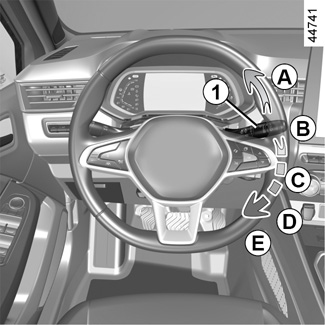
Vehicle fitted with intermittent windscreen wipers
A single sweep
A short push will trigger one sweep of the wipers.
B stop
C intermittent wiping
The wipers will pause for several seconds between sweeps. It is possible to change the time between sweeps by turning ring 2.
D slow continuous wiping
E fast continuous wiping
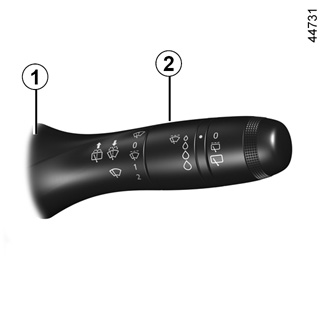
Special note
When driving the vehicle, the wiping speed slows down whenever the vehicle stops. For example, fast wiping speed will slow to normal wiping speed. As soon as the vehicle moves off, wiping will return to the speed originally selected.
If stalk 1 is operated, it overrides and cancels the automatic function.
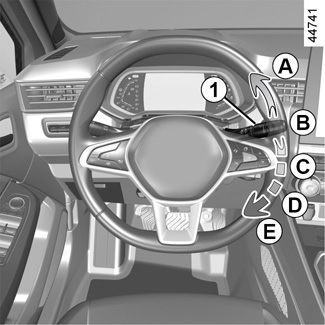
Vehicle fitted with front windscreen wiper rain sensor
The rain sensor is located on the windscreen, in front of the interior rear-view mirror.
A single sweep
A short push will trigger one sweep of the wipers.
B stop
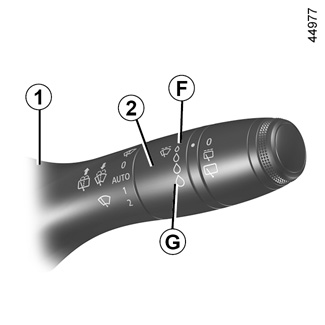
C automatic wiper function
When this position is selected, the system detects water on the windscreen and triggers the wipers at a suitable wiping speed. It is possible to change the triggering threshold and the time sweeps by turning ring 2:
- F: minimum sensitivity;
- G: maximum sensitivity.
The higher the sensitivity, the quicker the wipers will react and the faster the wipe.
When activating automatic wiping or when increasing sensitivity, one sweep of the blades is performed.
Note:
- the rain sensor is only intended as a driving aid. In the event of reduced visibility, the driver should manually activate the wipers. In foggy weather or during snowfalls, wiping is not automatically triggered and remains under the driver’s control;
- in the event of temperatures below zero, automatic wiping is not activated when the vehicle is started. It is automatically activated as soon as the vehicle exceeds a certain speed (approximately 5 mph (8 km/h));
- do not activate automatic wiping in dry weather;
- fully de-ice the windscreen before activating automatic wiping;
- when washing the vehicle under a roller type car wash, return the ring 1 to the B position to deactivate automatic wiping.
Operating faults
In the event of a malfunction of the automatic wiping, the wiper is set to intermittent wiping. Contact an authorised dealer.
The operation of the rain sensor may be interrupted in the event of:
- damaged windscreen wipers; a film of water or traces left by a blade in the sensor’s detection zone may increase the response time of the automatic wiper, or increase the wiping frequency;
- a windscreen with any chip or crack level with the sensor, or a windscreen covered in dust, dirt, insects, ice, the use of washing wax and water-repellent chemicals; the windscreen wiper will be less sensitive or may even not react at all.
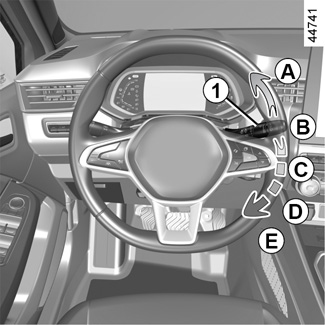
D slow continuous wiping
E fast continuous wiping
Special note
When driving the vehicle, the wiping speed slows down whenever the vehicle stops. For example, fast wiping speed will slow to normal wiping speed. As soon as the vehicle moves off, wiping will return to the speed originally selected.
If stalk 1 is operated, it overrides and cancels the automatic function.
Precautions
- In the event of ice, check whether the blades are stuck to the windscreen before operating the wiping mechanism. If you activate the wipers while the blades are stuck down with ice, you may risk damaging both the blade and the wiper motor.
- Do not activate the wipers on a dry screen. This will lead to premature wear or damage to the blades.
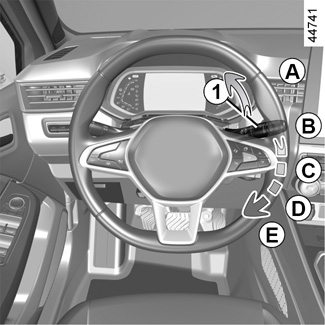
Specific front wiper position (service position)
This position enables the blades to be lifted to remove them from the windscreen.
It may be useful to:
- to clean the blades;
- to release the blades from the windscreen in winter;
- replace the blades WIPER BLADES: replacement.
With the ignition on or the engine running, lift the 1 stalk twice to position A (single sweep). The blades stop slightly away from the bonnet.
To return the blades to low position, with the ignition on, ensure that the wipers have folded down onto the windscreen, then move the stalk 1 to position A (single sweep).
Before switching on the ignition, place the wipers on the windscreen, there may otherwise be a risk of damage to the bonnet or the wipers when they are switched on.
Before carrying out any action involving the windscreen (washing the vehicle, de-icing, cleaning the windscreen etc.) return the 1 stalk to position B (stop).
Risk of injury and/or damage.
In the event of obstacles on the windscreen (dirt, snow, ice etc.), clean the windscreen (including the central area located behind the interior rear view mirror) before starting the wipers (risk of motor overheating).
If an object is preventing a blade from moving, it may stop functioning. Remove the obstacle and reactivate the wiper using the wiper stalk.
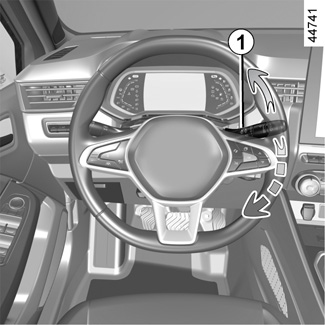
Windscreen washer
With the ignition on, pull stalk 1 then release.
A longer pull will trigger, in addition to the windscreen washer, two sweeps of the wipers followed, a few seconds later, by a third.
On vehicles fitted with a multimedia screen, you can choose to activate or disable the third sweep of the blades. VEHICLE SETTINGS CUSTOMISATION MENU.
Note:
In temperatures below zero, the washer liquid risks freezing to the windscreen, thereby reducing visibility. Heat the windscreen using the demister control before cleaning.
When working in the engine compartment, ensure that the windscreen wiper stalk is in position B (park).
Risk of injury.
Efficiency of a wiper blade
Check the condition of the wiper blades. How long they last depends on you:
- it must remain clean: clean the blade and the screen regularly with soapy water;
- do not use it when the screen is dry;
- free it from the screen when it has not been used for a long time.
In all cases, replace it as soon as it begins to lose efficiency: approximately once a year. WIPER BLADES: replacement.
Precaution for using the wipers
- In freezing or snowy weather conditions, clear the screen before starting the wipers (risk of motor overheating);
- ensure that no objects are obstructing the travel of the blade.